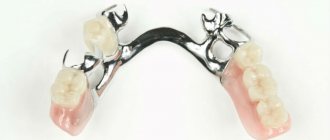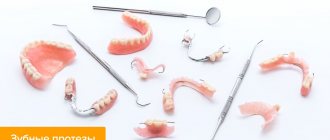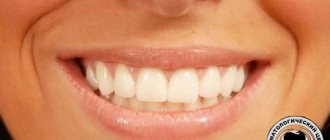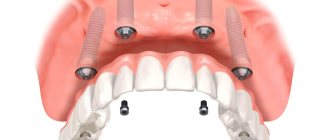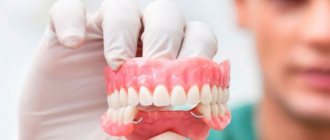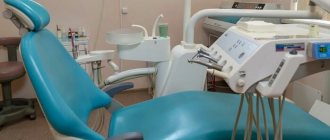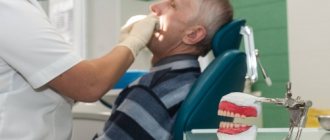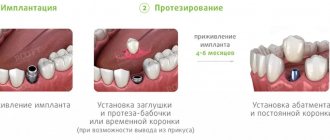Clasp dentures, popular in prosthetics, are not a new technology at all. The first development was proposed by a German doctor at the beginning of the last century. Hence the name. Bugel means “arc” in German.
This type of prosthesis is distinguished by its strength, reliability and durability. The design includes an arch on which artificial teeth are attached, a saddle (bridle), a base and a mount for supporting teeth. This structure ensures reliable fixation of the product in the oral cavity. Used to restore teeth with partial edentia.
In addition to reliability, the clasp denture preserves the functionality of the dentition and evenly distributes the load on the jaw. The design has a high level of aesthetics and does not cause discomfort when worn. The absence of a bulky base saves the patient from constant cleaning of the product. In addition, the prosthesis does not need to be removed at night. Let's talk about the nuances and types of products.
Classification
Clasp structures refer to a removable or conditionally removable method of prosthetics. They are divided by type of material and type of fastening. The base of the prosthesis, the arch, is made of three types of material:
- Made from medical alloy (cobalt, chromium).
- Noble metals (gold-platinum).
- Plastics.
It is obvious that metal-free clasp dentures are less durable, wear out quickly and break under load. However, it is an inexpensive alternative for patients with high sensitivities and metal allergies.
A more durable option is made from an alloy of gold and platinum. Also suitable for patients with allergies, but costs several times more.
How is prosthetics performed?
The dentist conducts an examination, takes diagnostic photographs and impressions. The use of clasp structures is recommended if the installation of fixed dentures or implantation is impossible or impractical.
The data is transmitted to the dental laboratory, where a plaster model is made.
Based on it, a design prototype is created. It is cast and scanned.
After scanning, a clasp prosthesis is modeled on a computer using a special program. With this “design”, the requirements of aesthetics, distribution of chewing load, preservation of the functionality of the dentition, etc. are taken into account.
After modeling, the prosthesis frame is made. It can be milled, solid-cast, soldered, or made using laser sintering. Milling and sintering are the most accurate methods (deviation up to 10 microns).
Intermediate fitting of the frame with subsequent correction is possible.
At the last stage, the gum-simulating base and artificial crowns are attached.
Mounting type
Fixation of clasp dentures is carried out due to the patient’s neighboring (healthy) teeth, which are used as a support. The structure can be fixed:
- Using locks. The upper part of the lock is placed inside the artificial teeth, and the lower part is in a metal crown, which is installed on the supporting teeth. This provides additional protection and reliability to your own teeth. And evenly distributes the load on the supporting teeth. Externally, the prosthesis looks very neat and aesthetically pleasing. And it can be easily removed if necessary. The disadvantage of the product is its high cost due to the use of additional materials.
- Hooks (clasps). The most affordable and simple fixation system. The hook grips the abutment tooth. The cast design and metal clasp guarantee high-quality fasteners and a tight fit to the tooth. Each hook is produced in accordance with the size, shape and anatomical features of the abutment tooth. Therefore, accidental loss of the structure from the mouth is excluded. The downside is that the hooks may be visible in the mouth. For example, when talking or eating.
- The third type of fixation is telescopic crowns. In this case, two crowns are used. The first is installed on the supporting dental unit. The second is inside the prosthesis. The size of both crowns is calculated so that the outer one fits tightly onto the inner one.
The last type of fastener is considered the most optimal. Even if the supporting tooth is destroyed, the inner crown will hold the denture. The adjustment will be minor. However, the development of a clasp prosthesis with telescopic fixation requires highly qualified specialists. Both a doctor and a dental technician.
Advantages
- Strong fixation. Even with clasps, the base is attached very firmly, the prosthesis lasts a long time. Telescopic crowns provide even more secure fastening. It will not be possible to remove it without the help of a doctor.
- Strong fixation. Even with clasps, the base is attached very firmly, the prosthesis lasts a long time. Telescopic crowns provide even more secure fastening. It will not be possible to remove it without the help of a doctor.
- Splinting abilities. The prosthesis can splint mobile teeth. This allows them to be used in the complex treatment of dental diseases.
- Long service life. On average, a clasp denture lasts about 10 years. With proper care, this period may be longer. Long-term operation is ensured by the strength of the structure and the reliability of its fixation.
pros
Unlike soft removable dentures, arch structures do not rub the gums and do not cause long-term addiction. Due to the tight fixation, the mobility of the product in the mouth is eliminated. The structure of the prosthesis does not block the palate - this preserves taste sensations during meals. In addition, the clasp denture does not block the movement of the tongue in the mouth. This does not distort diction and does not cause spasms of the facial muscles.
The distribution of load during chewing of food occurs according to the “one to two” principle. That is, one-third of the pressure is on the support unit and two-thirds on the beam system. The arc takes away part of the load, which protects soft tissues from damage and deformation. In classic removable dentures, the chewing load is directed to the gums and palate.
The structural features of the clasp prosthesis determine its shelf life. With proper care, the product will last at least 7 years, while soft prostheses provide functionality for up to 5-6 years. In the absence of a frame in soft removable dentures, the prosthetic bed quickly collapses.
Another advantage of the design is the possibility of parallel dental treatment with a prosthesis installed. Such products are called splinting - they simultaneously replace missing teeth and tightly fix existing ones.
Minuses
The choice of material and fastening can affect the price of the orthopedic structure. The cost can increase 2-3 times compared to analogues.
For metal clasp dentures, there remains a risk of allergies. In addition, the prosthesis cannot be used to restore the entire dentition. To fix the prosthesis, healthy supporting teeth are needed. An alternative is to install implants as support units.
The risk of receiving a low-quality product in the case of arc structures is also very high. You need to carefully choose specialists and a dental clinic for prosthetics.
If there are no outer teeth in the row, the process of fixing the prosthesis becomes more complicated. The structure only needs to be secured on one side. The locking method of fastening ensures good stability of the clasp denture in the mouth. However, the risk of spontaneous displacement still remains (end defect).
Price
The price of the prosthesis depends on what material was used in its manufacture, on the complexity of the technician’s work, and on the individual design features. In any case, our prices are acceptable for any person with average income.
The Denta Labor dental laboratory offers services for the production of locking clasp dentures, as well as other types of dentures and implants. You can consult with a specialist and find out prices for services by calling in Moscow (495) 162-08-25.
Contraindications
Clasp structures are not used in cases of complete edentia and the absence of outer teeth in a row. The presence of inflammation in the root canals of supporting teeth may delay the installation of a clasp denture for treatment. If the inflammation is not eliminated, it can lead to tooth loss. And, as a result, to replacing the prosthesis.
Limitations for installing a prosthesis also include incorrect bite, severe abrasion of the enamel, and allergies to the materials used.
For high-quality fixation of the structure in the oral cavity there must be at least 6 healthy teeth in the upper and lower jaw. Otherwise, you will have to choose another prosthesis or supplement the series with implants.
What is a clasp?
The clasp is a titanium, chromium-cobalt or gold-platinum frame in the shape of an arc with special fasteners. The main advantage of such dentures is their ability to rest not only on the gums, but also on the body of the jaw, palate, alveolar processes and healthy teeth.
Thanks to this design, the chewing load and pressure are evenly distributed over the entire dentition, preventing the process of loosening and premature loss of healthy teeth.
Nowadays, clasp prosthetics is becoming more and more in demand and popular.
This is due to a noticeable qualitative leap in the production of prosthetics. Modern clasps have a lightweight, durable, openwork design and practical fastenings that are invisible to prying eyes; they are durable, reliable and easy to use.
Design development
Like most types of prosthetics, the manufacture of a clasp prosthesis consists of two stages: preparation for installation and production of the structure.
It all starts with a thorough diagnosis of the patient’s jaw. The initial examination is complemented by an x-ray examination, which determines the condition of the teeth and root canals. It also shows the presence of pathologies in both jaws. In more complex cases, EspaDent clinic specialists use a modern 3D tomograph with layer-by-layer images of the jaw. During the diagnosis, the doctor also checks for allergic reactions to the materials used. Based on the clinical situation, wishes and capabilities of the patient, the dentist selects a suitable prosthesis.
The preparatory stage for installing a clasp prosthesis includes:
- Sanitation (cleaning) of the oral cavity.
- Elimination of carious cavities and inflammatory processes in supporting teeth.
- Grinding of teeth and fixation of crowns (for locking and telescopic structures).
Treatment of supporting teeth can cause discomfort, so the procedure is carried out using local anesthesia - safe and painless.
In order for the dental technician to begin making the partial denture, the doctor takes impressions of the prepared jaw. Then follows the calculation part, on the basis of which the specialist creates a wax model of the clasp. The sample is used to produce a metal arch onto which a temporary base and new teeth are installed.
The intermediate product is given for fitting. The patient evaluates the convenience of the design, the reliability of fixation in the oral cavity, and the level of comfort when moving the jaw. If necessary, the prosthesis is adjusted and then the final version is made. In the production of the base, artificial gum, plastic or nylon is used.
After installation, the doctor gives recommendations on how to care for the product. The process takes 3-4 weeks. The time frame may extend due to the need for preliminary dental treatment.
Design nuances for both jaws
The structure of the prosthesis depends on the installation site. For example, a clasp denture is installed on the upper jaw using locks and clasps (hooks). The first method is more popular because... In addition to fixation, the locks provide high-quality support during chewing loads. The hidden fastening mechanism of lock-type prostheses ensures high aesthetics and does not interfere with eating.
Indications for installing a prosthesis on the upper row is the impossibility of implantation. And also the so-called “flat palate” syndrome - atrophy of the alveolar processes.
Unlike the upper row, the clasp denture on the lower jaw can be attached in any of the available ways. The difference between the designs is the location of the arc and fixing elements. In an upper denture, the arch may be located in front or in the middle of the palate. There is also a difference in the shape of the arc: in the form of a jumper, a ring or a crescent.
Types of clasp dentures
Clasp dentures are classified as removable structures. They do not cause discomfort when worn. Many patients note that getting used to the “foreign body” occurs very quickly, already on the first day.
There are several types of clasp dentures:
- classic;
- acetal;
- combined
- splinting, etc.
Let's take a closer look at each type.
The classic version of the clasp prosthesis is a design with a metal arch that functions as a frame. Other elements are attached directly to the arch: part of the artificial gum and teeth.
The metal part of the prosthesis can be made of the following materials:
- titanium;
- cobalt chromium alloy;
- gold-platinum alloy.
Acetal clasp dentures differ from the classic type in that they are made without the use of metal elements. Acetate is used as the main material. Fastenings are also made from it. This material is biocompatible and does not cause allergic reactions. Prosthetics with acetal structures can restore the beauty of your smile.
Another type of clasp prosthesis is a combined prosthesis. It differs from other types, which implies the installation of a removable and non-removable structure. The latter is a supporting dental implant, which acts as a tooth root.
Care Tips
Any orthopedic structure will last longer if it is properly cared for. General recommendations for clasp dentures are simple:
- Clean your dentures regularly and thoroughly with a toothbrush.
- Rinse the structure after eating food.
- Periodically remove and soak the product in a special solution. Each structure has its own frequency at which the structure can be removed so as not to damage it. The doctor tells the patient about the peculiarities of care after installing the clasp prosthesis.
To avoid damaging the surface of the crowns, it is not recommended to use whitening pastes or too hard toothbrushes. It is also important to visit the dentist 1-2 times a year for preventive procedures.
